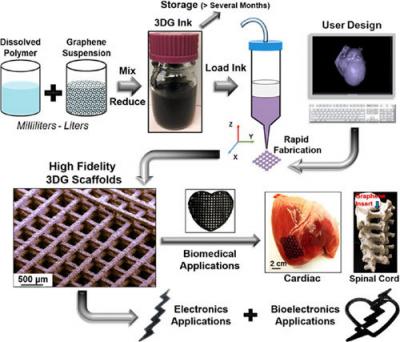Researchers at Northwestern University developed a solution-based graphene ink that can be 3D-printed under ambient conditions via simple extrusion into arbitrarily shaped, electrically conductive, mechanically resilient and biocompatible scaffolds with filaments ranging in diameter from 100 to 1000 µm. The resulting material is very flexible, can be easily printed into small or large scale (multiple centimeters) objects, and may hold the potential for printing electronics as well as body parts.

The printed objects contain a high level of graphene while maintaining structural integrity, which is enabled by the particular biocompatible elastomer binder PLG that was chosen in combination with the solvent system. This could be a revolutionary method for producing biomaterials for nervous tissue regeneration, and also biomaterials that are scalable and not very expensive to produce since these novel 3D printable graphene inks are relatively easy to produce, can be rapidly fabricated into an infinite variety of forms (including patient specific implants), and are also surgically friendly (can be adjusted to size and sutured to surrounding tissue).
The unique properties of this method could open the door to solving a variety of medical problems requiring the regeneration of damaged, degenerated or non-functional electrogenic tissues such as nerves, bone, or skeletal and cardiac muscle. Additional medical applications may be implantable biosensors and electrical devices. Outside of medicine, there is potential for use in biodegradable electronics or sensors in consumer products.